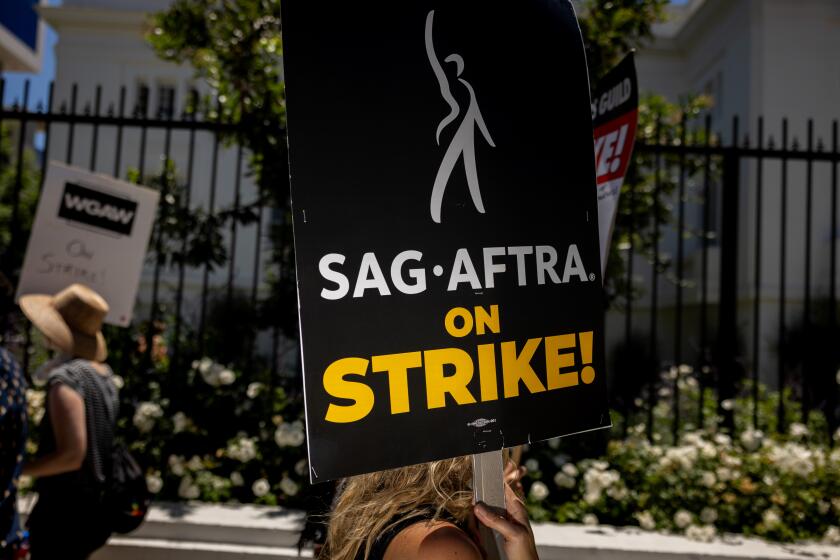What are residuals and how do they work? A Hollywood strike battleground, explained

- Share via
It’s not often that people get fired up over nitty-gritty financial mechanisms — but for the last 4½ months on the streets of Hollywood, that’s exactly what’s been happening.
As members of the Writers Guild of America and performers union SAG-AFTRA march down picket lines and shutter studio productions, a major focus of their ire has been the system of payouts that writers and actors earn when a project they’ve worked on gets replayed.
These residuals, as they’re known, are less flashy than some of the unions’ other priorities, such as artificial intelligence.
Inside the business of entertainment
The Wide Shot brings you news, analysis and insights on everything from streaming wars to production — and what it all means for the future.
You may occasionally receive promotional content from the Los Angeles Times.
Yet the importance of residuals to showbiz employees’ wallets is direct and undeniable. The checks can be comically small — getting one worth less than a dollar will earn you a drink at Studio City’s aptly named Residuals Tavern — and entertainment workers say the industry’s pivot toward streaming has made them particularly unreliable.
“I don’t get a piece from Netflix on ‘Breaking Bad’ to be totally honest,” said Aaron Paul, co-star of the wildly popular AMC drama, which found an expanded audience thanks to Netflix. “A lot of these streamers, they know they have been getting away with not paying people [a] fair wage and now it’s time to pony up.”
With no end to the strikes in sight, understanding residuals is key to understanding the divide between Hollywood’s labor and management.
So what are residuals, anyway?
Residuals are payments a writer, actor or director can earn when their work gets reused: for instance, if a movie featuring them airs on cable or a show they wrote finds a second life on streaming. Physical media sales, such as DVDs, as well as in-flight movies and digital rentals can also bring in residuals.
The 2023 writers’ strike is over after the Writers Guild of America and the Alliance of Motion Picture and Television Producers reached a deal.
“After the initial exhibition of whatever the work is — whether it’s theatrical or on television — any subsequent use of the work generates a residual,” said Joshua Edwards, a partner and entertainment lawyer at Fox Rothschild LLP. As the content moves through subsequent stages of distribution, Edwards added, each new market triggers additional payments.
Not everyone who works on a show or movie gets residuals. The WGA says writing residuals are only for credited writers, while SAG-AFTRA extends them to “principal” performers, including actors as well as stunt artists, pilots and puppeteers. Background actors aren’t eligible.
Why do they exist?
Residuals give creative professionals a cut of the payout when something they worked on enjoys a long tail of popularity.
SAG-AFTRA has approved a deal from the studios to end its historic strike. The actors were on strike for more than 100 days.
Television residuals first emerged in the 1950s, and the system expanded in 1960 when a joint strike of writers and SAG members secured actors a cut of the profits when movies reaired on network TV. Subsequent labor negotiations further expanded their scope.
“If a title is something that has a long lifetime and is continually licensed over and over again to different platforms, then that actor or writer should continue to benefit,” Edwards said.
That’s particularly important in an industry where work can be inconsistent. Residuals offer people in show business passive income, which can help them weather down periods — for instance, a protracted strike.
How are residuals calculated?
Residuals are calculated based on rules devised by the unions, including SAG-AFTRA and the WGA as well as the Directors Guild of America, or DGA.
The exact formula for determining residuals can be complicated.
Some of the factors that go into the calculation are, according to the different unions: the type of production, the distribution medium, the union contract at the time, how long the production took and the type of work someone did.
There are two basic types of residuals, according to the film industry finance and management firm Entertainment Partners. Some are a percentage of a project’s gross income, while others are a fixed payment — derived from a formula based on the characteristics of a given role and distribution model — which gets applied “every time a title reruns in a particular market.”
Viewership data from streaming services such as Netflix and Disney+ has become a major sticking point in the writers’ and actors’ strikes.
For instance, under WGA policy, residuals from made-for-TV projects can be based on either the project’s revenue or a mix of other factors including the type, length and budget of the project. With movies made for a theatrical release, the union says, residuals are always revenue-based.
For the most part “there’s no negotiation over the residual,” said Simon Pulman, a partner at Pryor Cashman LLP and co-chair of the firm’s entertainment group.
How did streaming change residuals?
With traditional film and TV projects, it’s relatively easy to equate viewership with profitability, such as by tracking box office ticket sales or Nielsen ratings.
But that process has gotten harder since Hollywood jumped headlong into the world of subscription-based streaming platforms, where watching an episode of “Stranger Things” on Netflix, for example, is less directly tied to revenue (a monthly subscription fee that confers access to the entire Netflix library).
“You could always connect entertainment and the consumption of entertainment with money,” said one former agent, who asked not to be named given the tensions of the strike. But nowadays the streamers “make their money off subscriptions, so [there’s] no way of knowing whether or not my show ... is directly correlated to a subscriber coming on board and generating revenue.”
In trying to adapt residuals to a streaming-centric world, Pulman said, industry stakeholders devised an “enormously complicated” formula that looked at a show or film’s length as well as how long it had been on the platform. But that calculation is not based on whether something is a hit or not, Pulman emphasized, meaning an extremely popular show could still pay out the same amount in residuals as a dud.
Residuals from high-end streaming platforms are based on fixed rates rather than revenue, and the platforms have 90 days before they owe actors residuals, Edwards said. That’s part of the reason why streaming platforms will often take down titles after a few months, he added; any later and the residuals would start kicking in.
What’s more, high-budget streaming residuals are only paid out annually.
“What they’ve tried to do is buy out the back end, and buy out the residuals, by paying people more upfront,” the former agent said of streaming. “You get overpaid for failure and underpaid for success.”
What do the unions want to change?
Both the actors and writers guilds have argued that, despite the massive popularity of direct-to-consumer platforms, the economics of streaming weren’t designed with workers’ best interests at heart.
Whereas a writer for a hit network television show might once have enjoyed six-figure residuals through reruns and syndication, streaming residuals are generally smaller. One actor told The Times this summer that his minor role in the 2015 dino romp “Jurassic World” earned him $1,400 in cable residuals but, over the same period, streaming brought in only $40.
Frustration, fears about the future and a high degree of mistrust continue to shape the script of Hollywood’s strikes by the WGA and SAG-AFTRA.
SAG-AFTRA has called for the casts of series on streaming platforms to share in those shows’ revenue. The Alliance of Motion Picture and Television Producers — which represents the major Hollywood studios in contract negotiations — rejected that proposal as giving actors all the reward with none of the risk, and instead suggested increased residuals for high-budget streaming shows.
The WGA, meanwhile, has called for increased residuals, including for high-budget streaming movies and international streaming, as well as a new “viewership-based streaming residual” that would reward the hits. The AMPTP countered in August with a proposal that included increased residuals for high-budget streaming movies and international streams, but not a viewership-based streaming residual. The WGA rejected the counter, a summary of which the AMPTP later publicly released after more back-and-forth.
Further, since the streaming platforms are generally hesitant to share their exact viewership numbers, the unions say it’s hard for workers to demand pay commensurate with their work’s popularity. SAG-AFTRA has proposed that a third-party company measure how different streaming shows perform, and that residuals be determined accordingly.
AMPTP member companies have balked at that idea. Instead, the studios have pitched confidential quarterly watch-time reports so that the writers guild can put forth a new residuals proposal in the future — a solution the WGA said would not allow for the level of specificity needed for individual writers to know how well their work is performing or what sort of residuals they might deserve.
More to Read
Inside the business of entertainment
The Wide Shot brings you news, analysis and insights on everything from streaming wars to production — and what it all means for the future.
You may occasionally receive promotional content from the Los Angeles Times.















